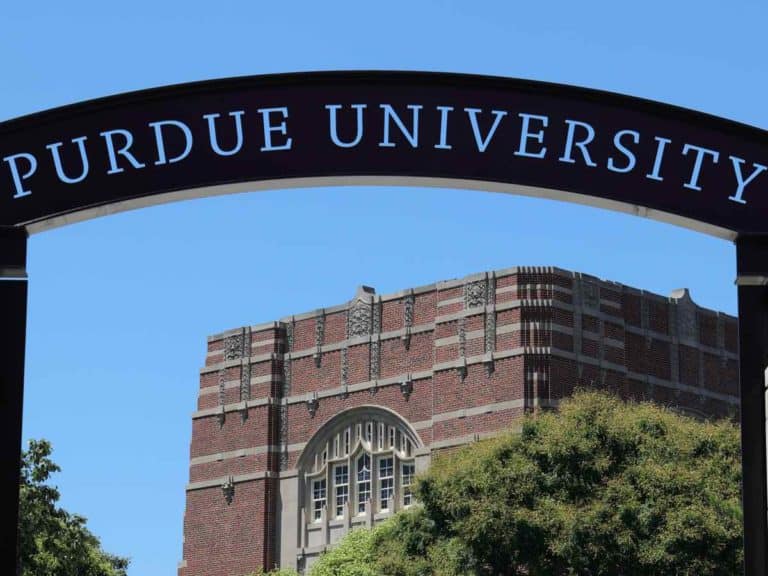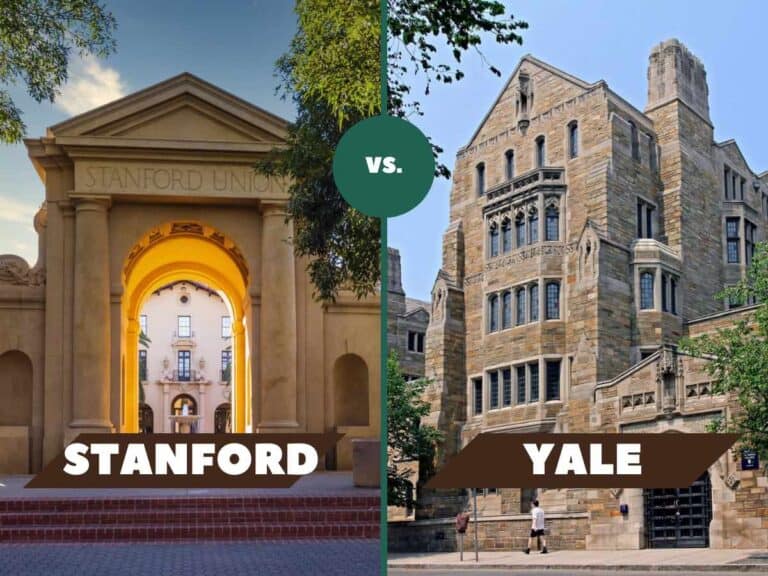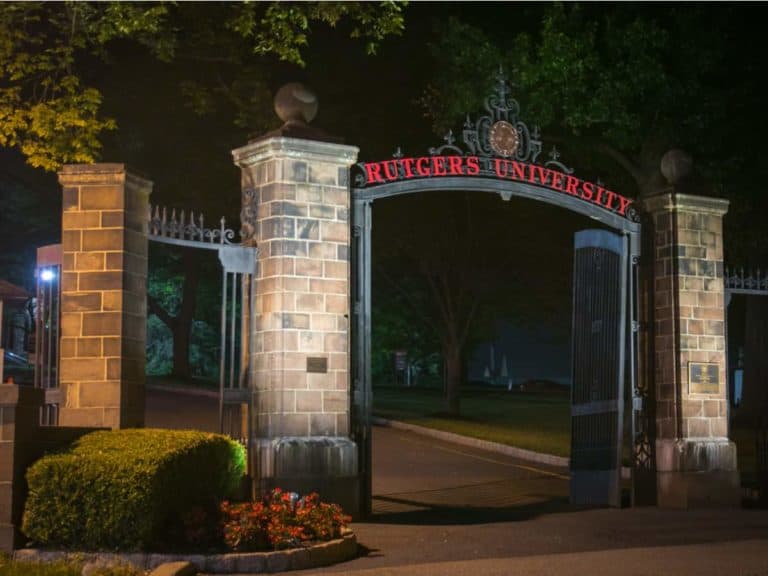All ACC Schools Ranked Academically
Atlantic Coast Conference (ACC) schools are competitive when it comes to sports.
It was formed in 1953 when 7 institutions of higher education located in the South Atlantic States parted ways with the Southern Conference, which is widely considered the OG super conference.
Since then, 8 other schools joined the conference and has claimed dozens of national championship titles throughout its history.
But ACC schools, which consist of various public and private institutions, are considered competitive not only in sports, most especially in football and basketball, but also in terms of academics — the majority of them are selective and also in the top 100 of the Best National Universities rankings of US News.
Planning on enrolling in a college where both sports and books are a huge part of campus life? Read on!
To give you an idea of all ACC schools I will talk about in this post, which, by the way, will be ranked academically, here’s a table of them in alphabetical order so that you may be able to quickly compare them with each other:
| Name | Joined ACC | US News Ranking | Best For |
| Boston College | 2005 | #36 in National Universities | Accounting |
| Clemson University | 1953 | #77 in National Universities | Student athletes |
| Duke University | 1953 | #10 in National Universities | Nursing |
| Florida State University | 1991 | #55 in National Universities | Party school |
| Georgia Institute of Technology | 1979 | #44 in National Universities | Engineering |
| North Carolina State University | 1953 | #72 in National Universities | Greek life |
| Syracuse University | 2013 | #62 in National Universities | Communications |
| University of Louisville | 2014 | #182 in National Universities | Sports management |
| University of Miami | 2004 | #55 in National Universities | Computer science |
| University of North Carolina at Chapel Hill | 1953 | #29 in National Universities | Study abroad |
| University of Notre Dame | 2013 | #18 in National Universities | Business |
| University of Pittsburgh | 2013 | #62 in National Universities | Nursing |
| University of Virginia | 1953 | #25 in National Universities | Student life |
| Virginia Tech | 2004 | #62 in National Universities | Architecture |
| Wake Forest University | 1953 | #29 in National Universities | Business |
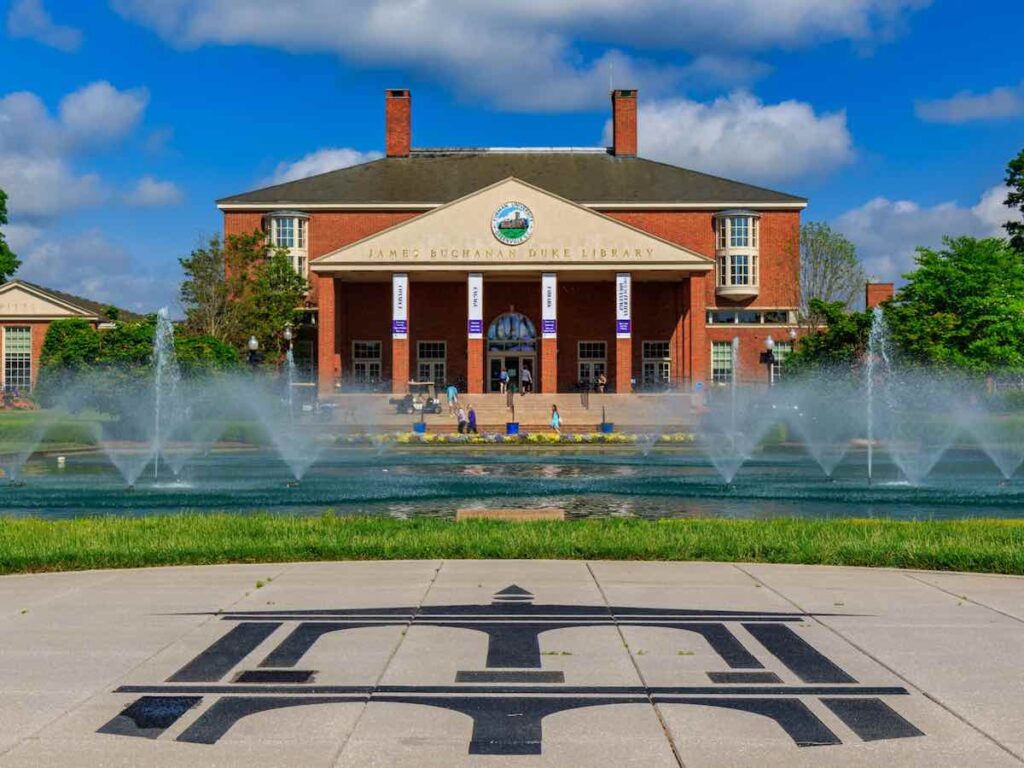
1. Duke University
- Location: Durham, North Carolina
- Enrollment: 17,620
- Acceptance rate: 6%
- Tuition and fees: $63,054
- Average GPA: 3.94
- SAT range: 1480 to 1570
- ACT range: 33 to 35
- Student-to-faculty ratio: 6:1
- Class size: Fewer than 20 students in 70% of classes
- Retention rate: 98%
- Graduation rate: 91%
- Alumni average starting salary: $88,200 per year
The 8,693-acre suburban campus of Duke University is home to 10 schools and colleges. Its undergraduate students, which make up only 39% of the total population, can choose from 53 majors.
Some of the most popular majors include computer science, public policy analysis, economics, biology, nursing, and political science and government.
Considered a Hidden Ivy and a Southern Ivy, Duke was founded in 1924 by James Buchanan Duke, who was from a family that built an empire in the manufacture of tobacco products and developed electricity production in the Carolinas.
It has a total of 27 varsity teams called the Blue Devils, and its mascot is, of course, the Blue Devil.

2. University of Notre Dame
- Location: Notre Dame, Indiana
- Enrollment: 13,139
- Acceptance rate: 15%
- Tuition and fees: $60,301
- Average GPA: 3.91
- SAT range: 1410 to 1550
- ACT range: 32 to 35
- Student-to-faculty ratio: 9:1
- Class size: Fewer than 20 students in 60% of classes
- Retention rate: 98%
- Graduation rate: 90%
- Alumni average starting salary: $63,100 per year
Accounting, finance management, management information systems, marketing — these are some of the University of Notre Dame’s most highly-ranked undergraduate business degree programs.
And some of the most popular majors include economics, finance, political science and government, mathematics, and information science.
Some famous people who attended Notre Dame include Condoleezza Rice, Phil Donahue and Regis Philbin.
The athletic teams of the institution are referred to as the Notre Dame Fighting Irish and its official mascot is the Leprechaun. As of this writing, Notre Dame has won a total of 11 national titles.

3. University of Virginia
- Location: Charlottesville, Virginia
- Enrollment: 26,026
- Acceptance rate: 21%
- Tuition and fees: $21,381 (in-state) and $56,837 (out-of-state)
- Average GPA: 3.85
- SAT range: 1390 to 1530
- ACT range: 32 to 35
- Student-to-faculty ratio: 15:1
- Class size: Fewer than 20 students in 52% of classes
- Retention rate: 97%
- Graduation rate: 89%
- Alumni average starting salary: $52,800 per year
Considered a Public Ivy and a Southern Ivy, the University of Virginia was founded in 1819 by none other than the author of the Declaration of Independence and the 3rd US President, Thomas Jefferson.
Its 1,682-acre suburban campus is located in the Academical Village, which is a UNESCO World Heritage Site.
US News ranks UVA #3 in Top Public Schools. On the other hand, Niche ranks it #4 in Top Public Universities in America and #1 in Top Public Universities in Virginia.
Some of the most popular sports at the public research university are baseball, soccer, golf, and track and field.
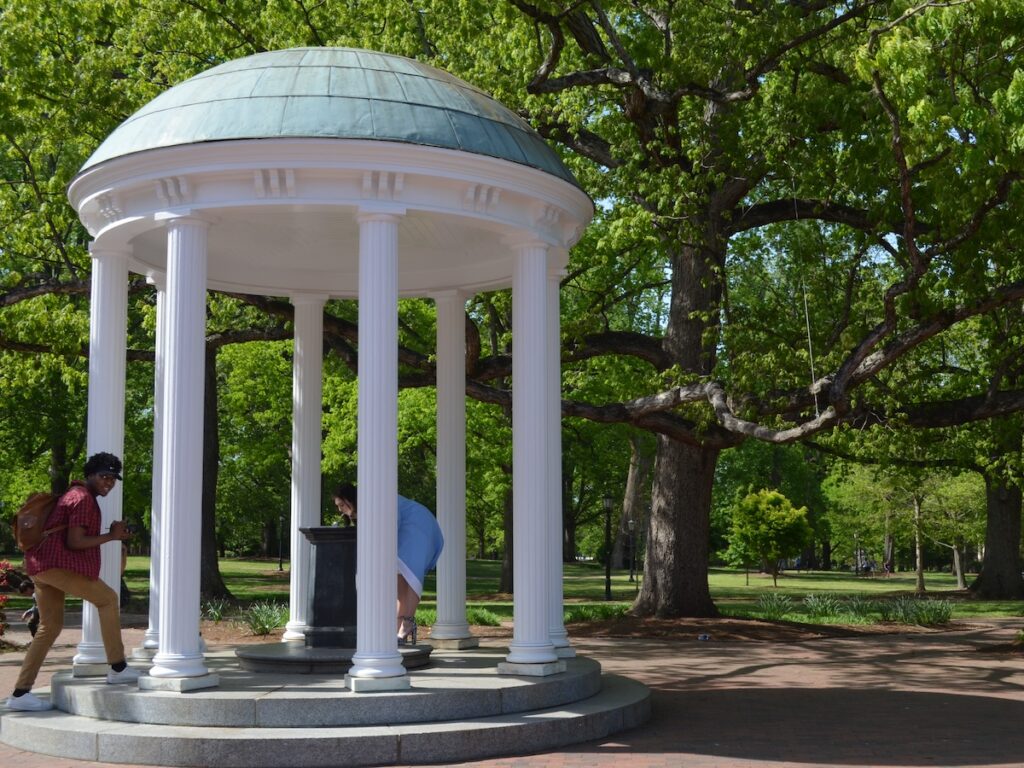
University of North Carolina at Chapel Hill
- Location: Chapel Hill, North Carolina
- Enrollment: 31,733
- Acceptance rate: 19%
- Tuition and fees: $8,998 (in-state) and $37,558 (out-of-state)
- Average GPA: 3.83
- SAT range: 1320 to 1510
- ACT range: 29 to 33
- Student-to-faculty ratio: 16:1
- Class size: Fewer than 20 students in 41% of classes
- Retention rate: 97%
- Graduation rate: 85%
- Alumni average starting salary: $48,600 per year
The first public university in the US and the flagship of the University of North Carolina system, the University of North Carolina at Chapel Hill is primarily known for its undergraduate business degree programs.
Having a Carnegie R1 designation for very high research activity and being regarded as a Public Ivy, the public research university offers its undergraduates over 70 academic majors and minors.
It’s also considered a big party school — Niche ranks it #4 in Top Party Schools in North Carolina.
The Tar Heels, which are UNC’s varsity teams, have won a total of 47 NCAA team championships in 7 different sports.
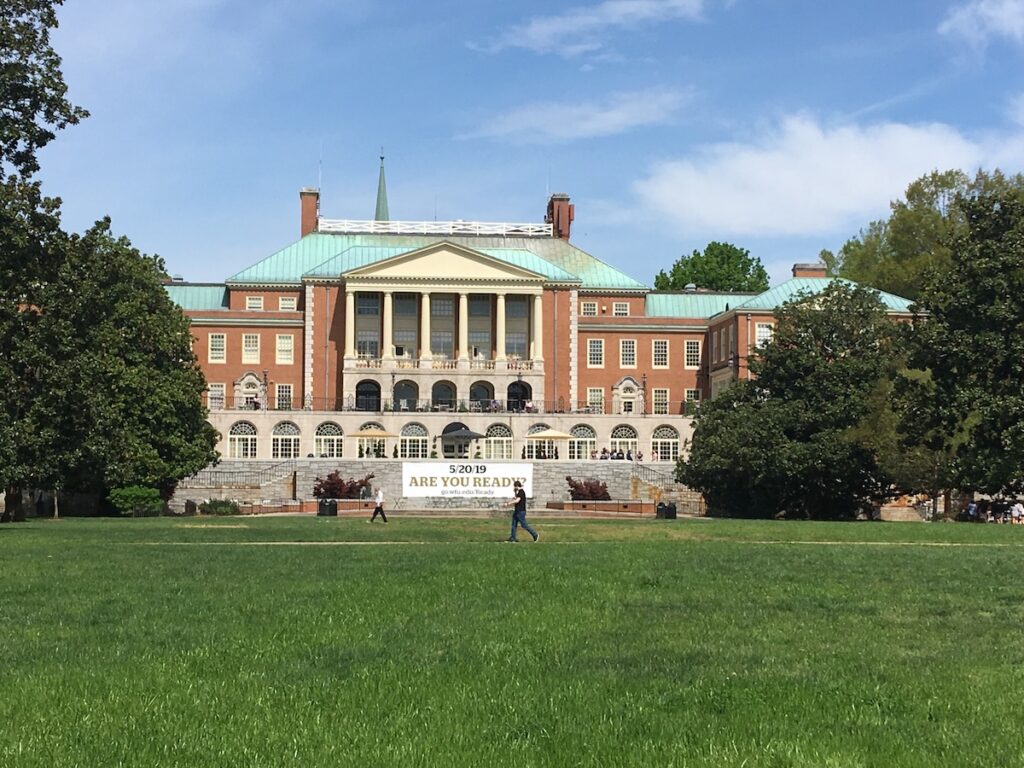
Wake Forest University
- Location: Winston-Salem, North Carolina
- Enrollment: 8,947
- Acceptance rate: 25%
- Tuition and fees: $62,128
- Average GPA: 3.90
- SAT range: 1350 to 1500
- ACT range: 30 to 33
- Student-to-faculty ratio: 11:1
- Class size: Fewer than 20 students in 57% of classes
- Retention rate: 94%
- Graduation rate: 86%
- Alumni average starting salary: $58,200 per year
The 340-acre suburban campus of Wake Forest University houses a total of 6 schools and colleges. Its undergraduate students, which make up 61% of its entire population, can choose from over 45 majors. Some of the most popular ones are political science and government, economics, communications, business, finance, psychology, and biology.
Many of its attendees take advantage of study abroad programs offered in over 70 countries worldwide.
Wake Forest is 1 of only 3 institutions with a small undergraduate population to have won NCAA team championships across a total of 5 sports: men’s golf, men’s soccer, men’s tennis, baseball and field hockey.

Boston College
- Location: Chestnut Hill, Massachusetts
- Enrollment: 15,046
- Acceptance rate: 19%
- Tuition and fees: $64,176
- Average GPA: 3.86
- SAT range: 1420 to 1530
- ACT range: 33 to 34
- Student-to-faculty ratio: 10:1
- Class size: Fewer than 20 students in 50% of classes
- Retention rate: 95%
- Graduation rate: 88%
- Alumni average starting salary: $65,700 per year
Founded in 1863, Boston College is the very first institution of higher education to operate in Boston.
Due to the fact that it’s a Catholic Jesuit university, there are no fraternities or sororities on campus.
But students can choose from more than 200 official clubs and organizations. What’s more, there are more than 100 majors available to undergraduates, and some of the most sought-after are finance, economics, psychology, biology and communications.
Competing in almost 30 NCAA varsity sports, the Eagles, or what the school’s varsity players are known, has won a total of 5 team national championships as well as 6 national championships in collegiate sailing.

Georgia Institute of Technology
- Location: Atlanta, Georgia
- Enrollment: 43,844
- Acceptance rate: 18%
- Tuition and fees: $11,764 (in-state) and $32,876 (out-of-state)
- Average GPA: 3.90
- SAT range: 1360 to 1540
- ACT range: 31 to 35
- Student-to-faculty ratio: 21:1
- Class size: Fewer than 20 students in 34% of classes
- Retention rate: 97%
- Graduation rate: 51%
- Alumni average starting salary: $62,100 per year
Also known as Georgia Tech, Georgia Institute of Technology was founded in 1885 and is a part of the University System of Georgia. Originally, it offered only an undergraduate degree in engineering. These days, however, it has more than 100 degree programs, many of which are technically-focused ones.
Needless to say, some of the most highly-ranked undergraduate degree programs it offers are engineering ones. It also tends to attract degree-seeking students who are on the lookout for top-notch computer science and business curriculum.
At Georgia Tech, the most popular sport is football, although its men’s basketball team is revered, too.
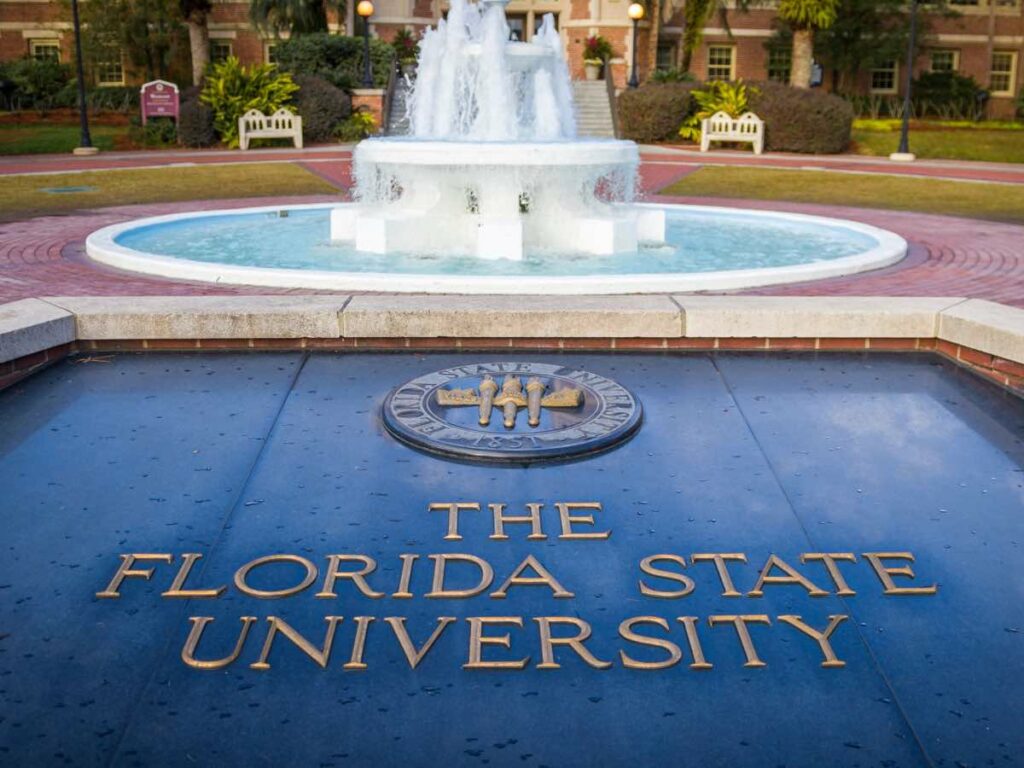
Florida State University
- Location: Tallahassee, Florida
- Enrollment: 45,130
- Acceptance rate: 37%
- Tuition and fees: $6,517 (in-state) and $21,683 (out-of-state)
- Average GPA: 3.60
- SAT range: 1180 to 1340
- ACT range: 26 to 30
- Student-to-faculty ratio: 22:1
- Class size: Fewer than 20 students in 64% of classes
- Retention rate: 94%
- Graduation rate: 70%
- Alumni average starting salary: $37,800 per year
Founded in 1851, Florida State University is a member of the State University System of Florida. Bearing a Carnegie R1 designation for its very high research activity, the public research university consists of 16 different schools and colleges as well as more than 100 research centers, facilities and institutes. It offers 103 baccalaureate programs.
Some of the top majors at FSU include finance, psychology, communications, marketing, biology, accounting, computer hardware engineering, medical assistant, nursing and economics.
It also attracts lots of party-goers — Niche ranks it #3 in Top Party Schools in America and #1 in Top Party Schools in Florida.
The institution has 20 varsity teams, the Florida State Seminoles, and their official colors are garnet and gold.

University of Miami
- Location: Coral Gables, Florida
- Enrollment: 19,096
- Acceptance rate: 28%
- Tuition and fees: $57,194
- Average GPA: 3.70
- SAT range: 1300 to 1460
- ACT range: 30 to 33
- Student-to-faculty ratio: 13:1
- Class size: Fewer than 20 students in 51% of classes
- Retention rate: 92%
- Graduation rate: 73%
- Alumni average starting salary: $54,000 per year
According to the University of Miami itself, around 3,900 international students, undergraduates and graduate students alike, from 120 countries across the planet head to the institution’s 239-acre suburban campus to study and conduct research.
Some of the most highly ranked undergraduate degree programs offered by the private research school include engineering, computer science, business and nursing.
There are more than 200 majors and minors to choose from, and most of UM’s graduates have majored in nursing, finance, psychology, business, marketing, and computer science.
The Miami Hurricanes, which are its varsity teams, have won 21 national team championships, among others.
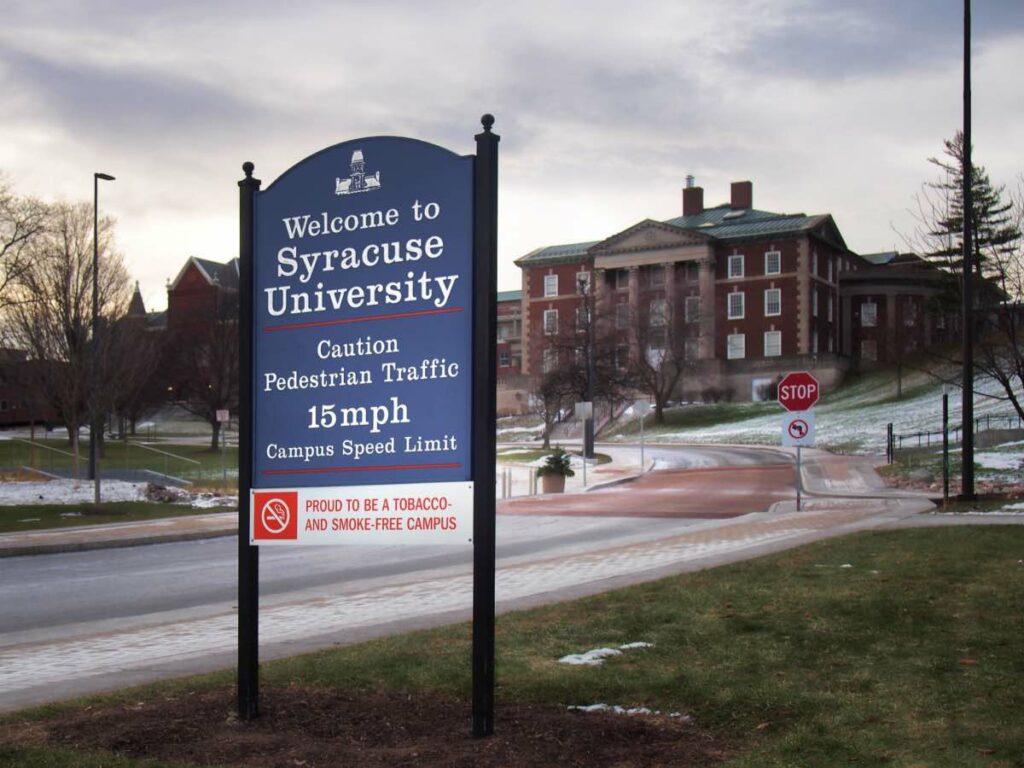
Syracuse University
- Location: Syracuse, New York
- Enrollment: 21,772
- Acceptance rate: 59%
- Tuition and fees: $60,135
- Average GPA: 3.70
- SAT range: 1220 to 1400
- ACT range: 27 to 32
- Student-to-faculty ratio: 14:1
- Class size: Fewer than 20 students in 64% of classes
- Retention rate: 90%
- Graduation rate: 72%
- Alumni average starting salary: $46,100 per year
Consisting of a total of 13 schools and colleges, Syracuse University holds a Carnegie R1 classification for its very high research activity.
While it was associated with the Methodist Episcopal Church, the private research university, where freshmen and sophomore students are required to live on campus, has become non-sectarian 50 years after its founding.
Undergraduates can choose from 200 plus majors and more than 100 minors. There are over 300 student clubs and organizations available and it offers more than 100 study abroad programs.
As of this writing, Syracuse’s varsity teams have won 30 national team titles across 7 sports.
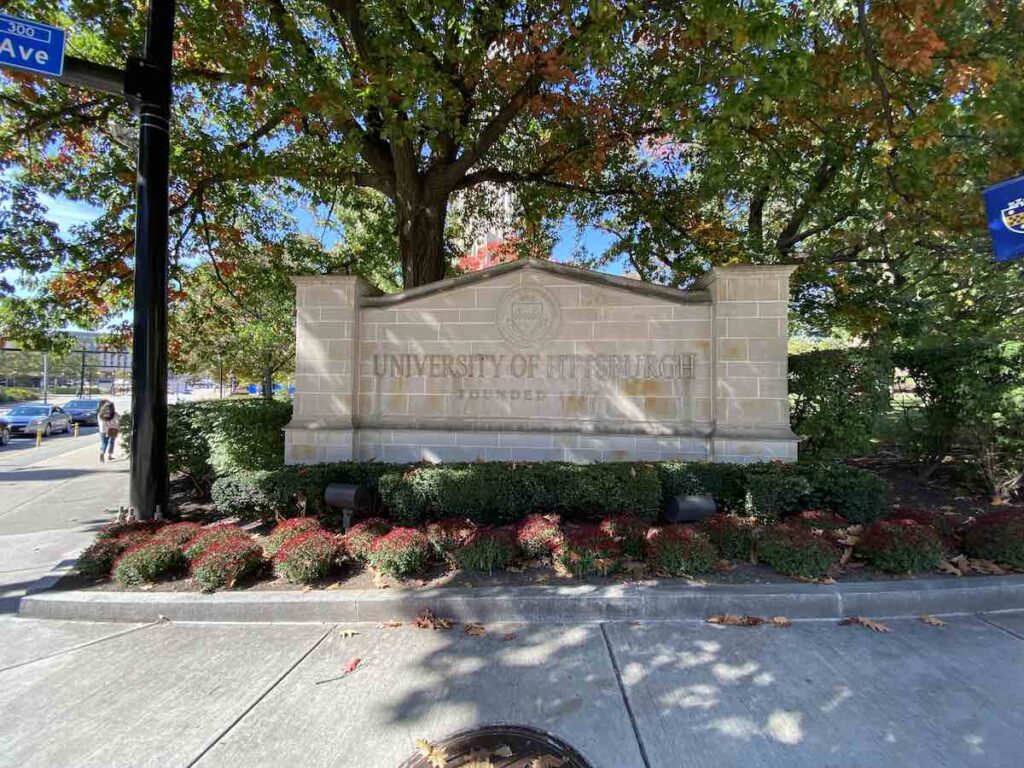
University of Pittsburgh
- Location: Pittsburgh, Pennsylvania
- Enrollment: 29,238
- Acceptance rate: 67%
- Tuition and fees: $19,760 (in-state) and $36,000 (out-of-state)
- Average GPA: 3.90
- SAT range: 1250 to 1470
- ACT range: 28 to 33
- Student-to-faculty ratio: 14:1
- Class size: Fewer than 20 students in 42% of classes
- Retention rate: 93%
- Graduation rate: 69%
- Alumni average starting salary: $42,000 per year
Also referred to as Pitt, the University of Pittsburgh stems from the Pittsburgh Academy, which was founded in 1787 when Pittsburgh was experiencing rapid growth. These days, the public research institution consists of 17 undergraduate and graduate schools and colleges. It’s particularly known for its School of Medicine.
Due to this, it doesn’t come as a surprise that one of the most highly-ranked degree programs at Pitt is nursing, although its engineering, computer science and business programs are sharing the spotlight, too.
Football and basketball — are the most popular sports at the institution with a Carnegie R1 designation.
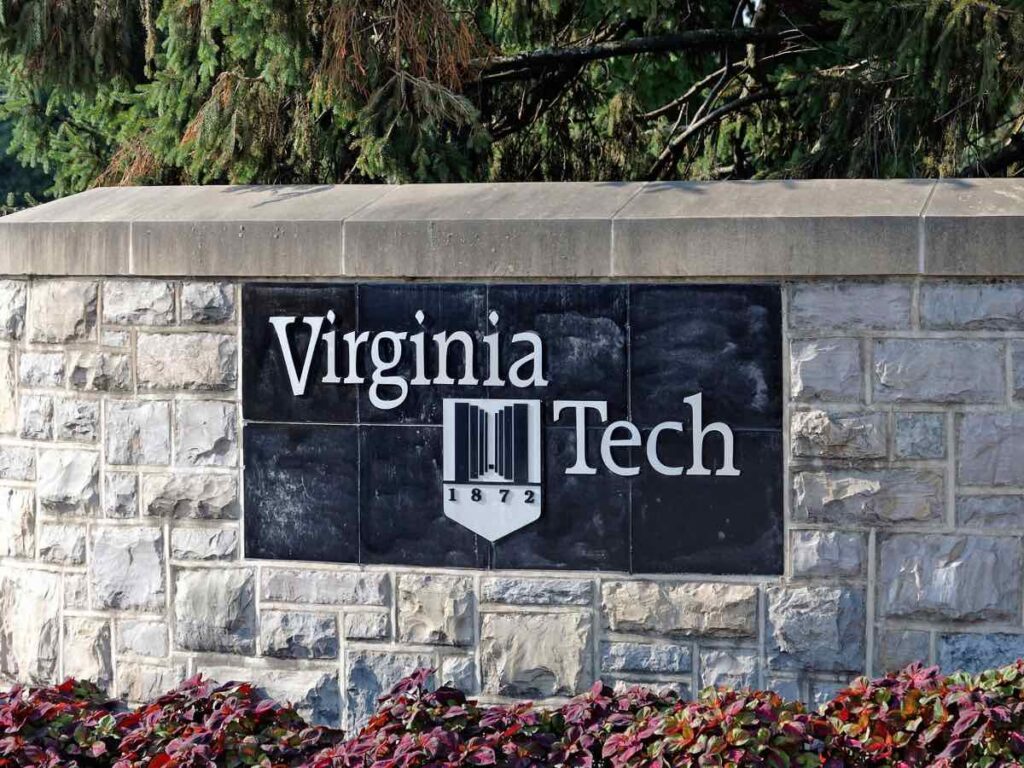
Virginia Tech
- Location: Blacksburg, Virginia
- Enrollment: 37,279
- Acceptance rate: 56%
- Tuition and fees: $15,208 (in-state) and $34,838 (out-of-state)
- Average GPA: 3.90
- SAT range: 1210 to 1410
- ACT range: 26 to 32
- Student-to-faculty ratio: 13:1
- Class size: Fewer than 20 students in 38% of classes
- Retention rate: 93%
- Graduation rate: 68%
- Alumni average starting salary: $49,200 per year
Officially known as Virginia Polytechnic Institute and State University, Virginia Tech has a handful of educational facilities in the US as well as research centers and study abroad sites outside of the country.
There are more than 150 majors undergraduates can choose from.
Of those, some of the most popular are management sciences and information systems, mechanical engineering, information science, biology, finance, psychology, and architecture.
On the other hand, some of its highly-ranked undergraduate degree programs include engineering and business.
With 39 intramural sports, gyms, aquatic centers and over 100 group exercises classes taught every week, students do not have to be members of Virginia Tech’s varsity teams to partake in sports and related activities.

North Carolina State University
- Location: Raleigh, North Carolina
- Enrollment: 36,831
- Acceptance rate: 47%
- Tuition and fees: $9,128 (in-state) and $30,869 (out-of-state)
- Average GPA: 3.80
- SAT range: 1270 to 1440
- ACT range: 27 to 32
- Student-to-faculty ratio: 15:1
- Class size: Fewer than 20 students in 39% of classes
- Retention rate: 94%
- Graduation rate: 64%
- Alumni average starting salary: $42,800 per year
A member of the University of North Carolina system, North Carolina State University is regarded as the largest postsecondary institution in all of the Carolinas. Founded in 1887, it’s known to excel in science, technology, engineering and math. It also has a Carnegie R1 designation for having very high research activity.
Its massive 2,137-acre campus with a city setting is home to 36,831 students, around 72% of which are undergraduates. And speaking of which, NC State’s undergraduates can choose from over 100 majors and 120 minors.
The public research institution takes pride in the fact that it offers sports in practically any athletic event imaginable.

Clemson University
- Location: Clemson, South Carolina
- Enrollment: 27,341
- Acceptance rate: 49%
- Tuition and fees: $15,558 (in-state) and $39,502 (out-of-state)
- Average GPA: 3.90
- SAT range: 1220 to 1420
- ACT range: 27 to 32
- Student-to-faculty ratio: 16:1
- Class size: Fewer than 20 students in 33% of classes
- Retention rate: 93%
- Graduation rate: 65%
- Alumni average starting salary: $45,100 per year
In terms of enrollment, Clemson University is the second-largest institution of higher education in South Carolina. When it was founded in 1889, its mission was to be a high seminary of learning dedicating itself to teaching, research and service.
Currently, students can choose from more than 400 on-campus clubs and organizations, and around a quarter of its population is a part of Greek life.
Some of the most popular majors among undergraduates include business, marketing, psychology, biology, industrial engineering, mechanical engineering, finance, nursing, and information science.
Throughout its athletic history, Clemson has bagged a total of 6 national championship titles across 3 sports.
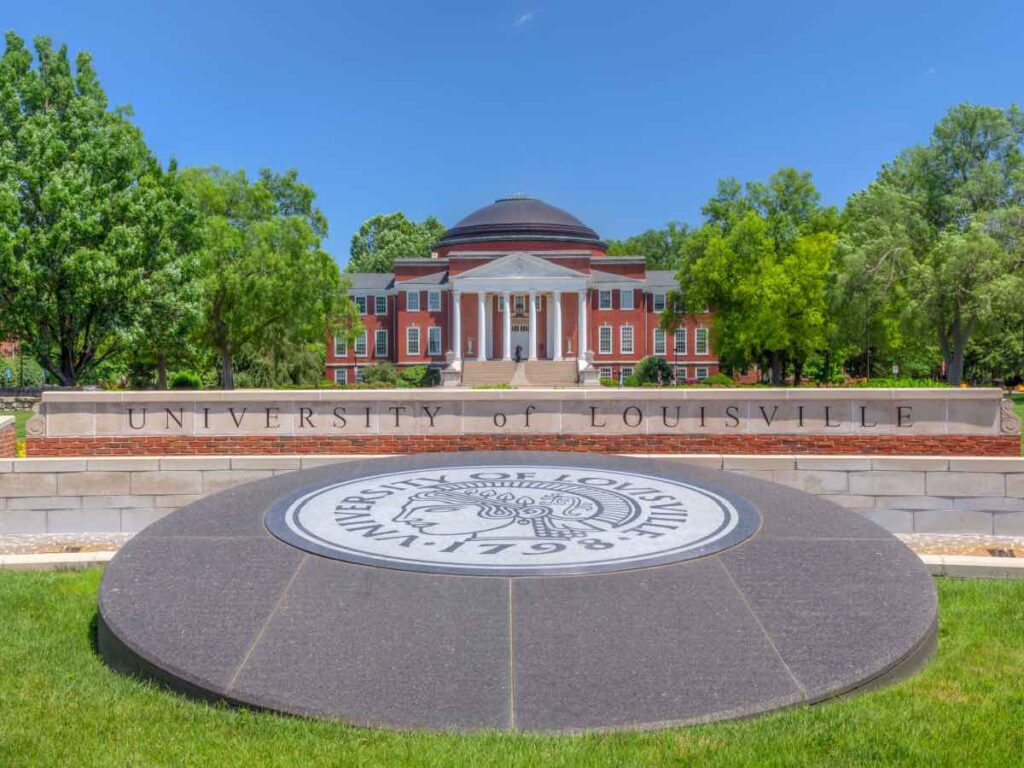
University of Louisville
- Location: Louisville, Kentucky
- Enrollment: 22,140
- Acceptance rate: 74%
- Tuition and fees: $12,370 (in-state) and $28,716 (out-of-state)
- Average GPA: 3.60
- SAT range: 1050 to 1270
- ACT range: 20 to 28
- Student-to-faculty ratio: 13:1
- Class size: Fewer than 20 students in 43% of classes
- Retention rate: 81%
- Graduation rate: 40%
- Alumni average starting salary: $37,300 per year
A part of the Kentucky state university system, the University of Louisville was the very first city-owned public university in the US. These days, it’s known for having a diverse student body and fostering equity and inclusion. Around 71% of its population are undergraduates, while only approximately 1% consists of international students.
Some of the most popular majors at UofL include sports management, nursing, communications, psychology, marketing, and criminal justice and law enforcement administration. There are more than 200 degree programs available.
Its varsity teams are called the Louisville Cardinals or simply the Cards, which have won 3 NCAA titles.
Disclaimer: The views and opinions expressed in this article are those of the authors and do not necessarily represent those of the College Reality Check.

